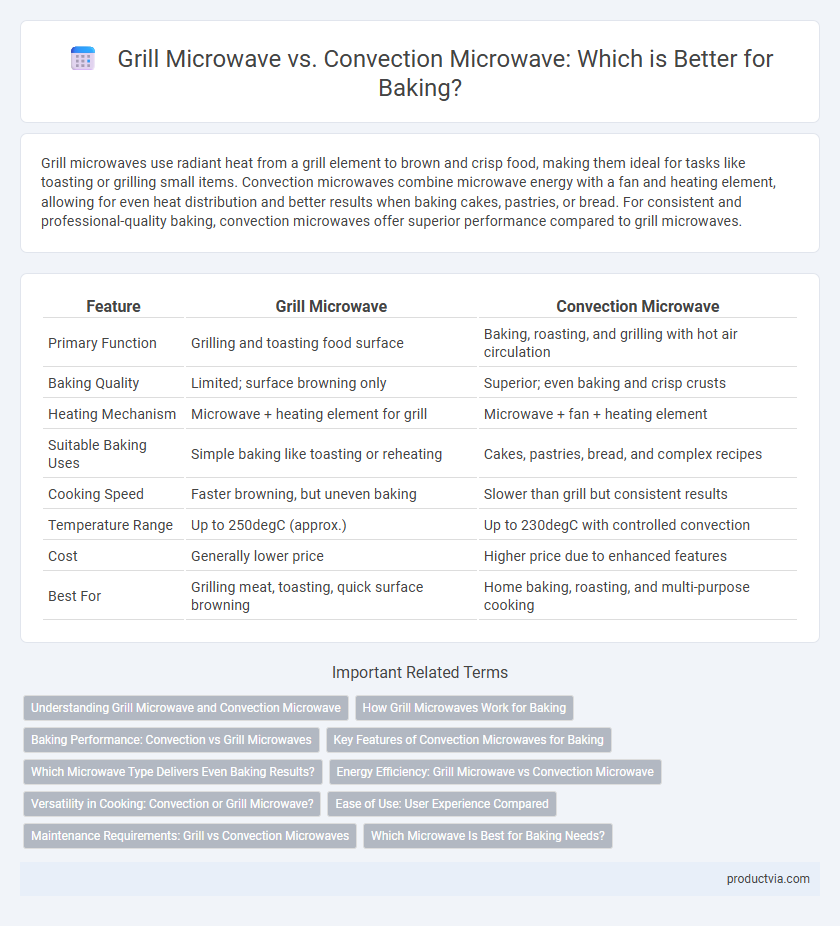Grill microwaves use radiant heat from a grill element to brown and crisp food, making them ideal for tasks like toasting or grilling small items. Convection microwaves combine microwave energy with a fan and heating element, allowing for even heat distribution and better results when baking cakes, pastries, or bread. For consistent and professional-quality baking, convection microwaves offer superior performance compared to grill microwaves.
Table of Comparison
| Feature | Grill Microwave | Convection Microwave |
|---|---|---|
| Primary Function | Grilling and toasting food surface | Baking, roasting, and grilling with hot air circulation |
| Baking Quality | Limited; surface browning only | Superior; even baking and crisp crusts |
| Heating Mechanism | Microwave + heating element for grill | Microwave + fan + heating element |
| Suitable Baking Uses | Simple baking like toasting or reheating | Cakes, pastries, bread, and complex recipes |
| Cooking Speed | Faster browning, but uneven baking | Slower than grill but consistent results |
| Temperature Range | Up to 250degC (approx.) | Up to 230degC with controlled convection |
| Cost | Generally lower price | Higher price due to enhanced features |
| Best For | Grilling meat, toasting, quick surface browning | Home baking, roasting, and multi-purpose cooking |
Understanding Grill Microwave and Convection Microwave
Grill microwaves use a heating element to brown and crisp food surfaces, making them ideal for grilling and toasting but less effective for even baking. Convection microwaves combine microwave energy with a fan and heating element, enabling hot air circulation for uniform baking and roasting, closely mimicking a traditional oven. Understanding the distinct cooking methods helps determine the best appliance for baking needs, with convection microwaves offering more consistent and versatile baking performance.
How Grill Microwaves Work for Baking
Grill microwaves use a heating element, typically a metal coil, that radiates infrared heat to brown and crisp the surface of baked goods while the microwave function cooks the interior. This combination allows for effective baking of items like pizzas and pastries, creating a crispy exterior similar to traditional grilling. The radiant heat from the grill element intensifies Maillard reactions, enhancing flavor and texture in the final baked product.
Baking Performance: Convection vs Grill Microwaves
Convection microwaves provide even heat distribution and consistent temperature control, making them ideal for baking cakes, bread, and pastries with perfect crusts and textures. Grill microwaves use radiant heat primarily for browning and crisping but lack the precise temperature regulation needed for thorough and uniform baking. For superior baking performance, convection microwaves deliver professional-quality results by baking foods evenly inside and out.
Key Features of Convection Microwaves for Baking
Convection microwaves combine microwave energy with a heating element and a fan, providing even heat distribution essential for consistent baking results. Their key features include precise temperature control, a built-in convection fan for uniform heat circulation, and multiple cooking modes that allow for baking, roasting, and browning with crisp, golden finishes. These capabilities enable users to bake bread, cakes, and pastries with texture and taste comparable to traditional ovens.
Which Microwave Type Delivers Even Baking Results?
Grill microwaves use radiant heat from a heating element to brown and crisp food but may result in uneven baking due to limited heat circulation. Convection microwaves combine microwave energy with a built-in fan and heating element that circulate hot air, ensuring consistent temperature distribution for more even baking results. For baking applications requiring uniform doneness and texture, convection microwaves deliver superior performance compared to grill microwaves.
Energy Efficiency: Grill Microwave vs Convection Microwave
Grill microwaves generally consume less energy than convection microwaves because they use direct radiant heat primarily for grilling and browning, making them more efficient for simple baking tasks. Convection microwaves employ a fan to circulate hot air, providing uniform baking but requiring higher energy consumption to maintain consistent heat. For energy-efficient baking, grill microwaves offer a lower power option, while convection microwaves deliver better cooking quality at the cost of increased electricity usage.
Versatility in Cooking: Convection or Grill Microwave?
Convection microwaves offer greater versatility in cooking by combining microwave energy with a convection fan and heating element, enabling not only grilling but also baking, roasting, and crisping, making them ideal for a wide range of culinary tasks. Grill microwaves primarily provide grilling capabilities through a heating element and grill rack but lack the airflow and even heat distribution that convection microwaves deliver for optimal baking results. Choosing a convection microwave enhances cooking flexibility, allowing users to bake cakes and pastries evenly while still enjoying the grilling function, whereas grill-only microwaves are best suited for simple grilling needs.
Ease of Use: User Experience Compared
Grill microwaves offer straightforward controls and quick setup, making them ideal for users who prefer simple baking tasks with minimal adjustments. Convection microwaves provide versatile baking options with precise temperature settings, but their more complex interface may require a learning curve. User experience favors grill microwaves for ease of use, while convection microwaves suit those seeking advanced baking capabilities.
Maintenance Requirements: Grill vs Convection Microwaves
Grill microwaves require less complex maintenance due to their simpler heating elements, primarily involving the cleaning of grill racks and occasional replacement of grill heaters. Convection microwaves demand more meticulous care, including regular cleaning of the fan and heating coils to prevent grease buildup that can affect baking performance. Proper upkeep of convection microwaves ensures consistent heat distribution, which is crucial for achieving uniform baking results.
Which Microwave Is Best for Baking Needs?
Grill microwaves offer high heat directly from the top element, making them ideal for crisping and browning baked goods like pizzas or casseroles, but they may not distribute heat evenly for more delicate baking tasks. Convection microwaves combine microwave energy with a fan-forced hot air system, ensuring uniform heat distribution that produces better rise and texture in cakes, cookies, and bread. For consistent, professional-quality baking results, convection microwaves are generally the best choice.
Grill microwave vs Convection microwave for baking Infographic

 productvia.com
productvia.com